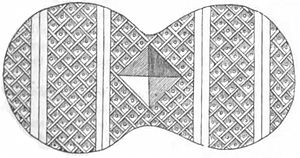This extraordinary ceremonial was no coinage of the Spanish priests, for Acosta calls it "a communion which the devil himself, the prince of pride, ordained in Mexico, to counterfeit the Holy Sacrament !"[1]
Thus magnificent as was the god of War, he did not disdain, according to tradition, to take unto himself a very hideous partner, whose monstrous and horrible figure has been preserved to these times in the statue, drawings of which are given at the commencement of this letter.
Teoyaomiqui, the wife of Huitzilopotchtli, was the goddess who conducted the souls of the warriors, who died in defence of their altars, to the Mexican Elysium—the House of the Sun.
The figure on the opposite page represents the front of this idol—the breasts denoting the sex. At the sides of these, and beneath, are four hands, displaying the open palms, while above and between the hands are sacks, or purses in the shape of gourds, which, according to Don Fernando de Alvarado Tezozomoc, represented "the woven purses" of a blue color, filled with copal, that were offered to the idol containing the sacred incense used at the election and funeral ceremonies of Kings, and burned with the bodies or hearts of the captives slain to accompany the deceased sovereign on his journey to the world of spirits.
In front of the waist, a death-head is attached. The strap by which these skulls are held, will be perceived in the second figure, which exhibits the statue in profile.
The knots of serpents, the feathers, the shells, and the nails or claws forming the lower part of the figure, are said by De Gama[2] to be the insignia of other gods connected with Teoyaomiqui or her husband; while all those above the waist, both in front and behind, are symbols of that deity herself. The top of the statue is represented in the following drawing:

- ↑ The figure of the Holy Cross has been found in Mexico, and a drawing of one discovered at Palenque, is given by Mr. Stephens in his first volume. It is known that as the symbol of matter. Among the Irish it was the symbol of knowledge, and Garcilaso de la Vega informs us that the ancient Peruvian had "a cross of white marble which they held in great veneration, but did not adore." They could give no reason for the respect they paid it.
- ↑ P.36 Discripcion Historica y Cronologica.
